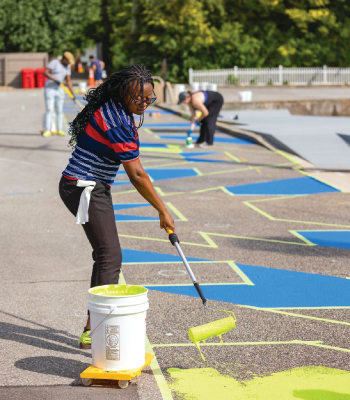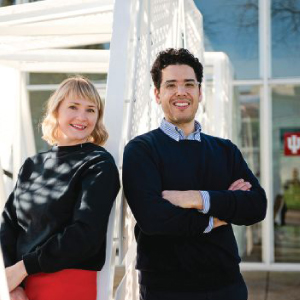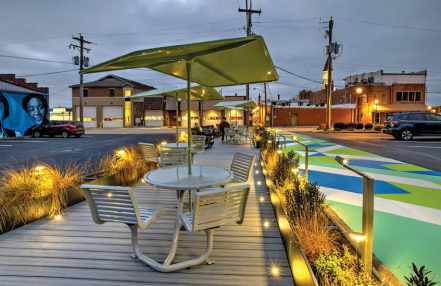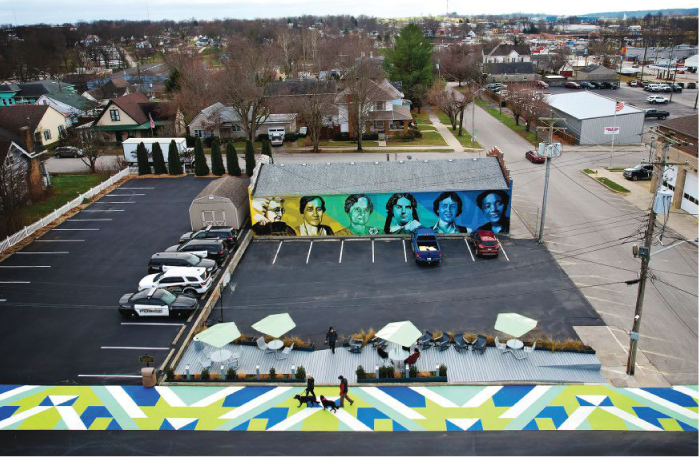Heritage Park featured in May 2022 Landscape Architecture Magazine

From May 2022 Landscape Architecture Magazine
The Magazine of the American Society of Landscape Architects
By Timothy A. Schuler
A NOOK? A CRANNY?
THE DESIGNERS AT LAA OFFICE CAN WORK WITH THAT.
 Lulu Loquidis, ASLA, and Daniel Luis Martinez founded LAA Office in Columbus, Indiana, in 2018.
Lulu Loquidis, ASLA, and Daniel Luis Martinez founded LAA Office in Columbus, Indiana, in 2018.
Lulu Loquidis, ASLA, and Daniel Luis Martinez are comfortable in the gaps. As the founders of the multidisciplinary practice LAA Office (pronounced “law office”), the designers’ work exists between the disciplines of landscape, art, and architecture and, more often than not, in the voids of the built environment. Even their chosen home of Columbus, Indiana, represents a certain enthusiasm for the in-between.
“That willingness to explore the territory between disciplines is something that I think we were pretty keen on early on. And it’s been really fruitful, not only in Columbus, but we’re starting to work now generally in the Midwest, in Southern Indiana, in towns that are smaller than Columbus, and a lot of the driving force behind it is looking at these spaces between disciplines,” Martinez says.
The duo moved to Columbus in 2018, after Martinez accepted a teaching position in Indiana University’s newly established graduate architecture program in Columbus. The change opened new horizons. “Moving to the Midwest, we realized that most of our country does not look like New York City,” Loquidis, a landscape architect, says. “It’s opened up a broader view of our country and what it’s like,” Martinez adds.
A recent project in Salem, Indiana, exemplifies the designers’ interest in working with communities to reveal the artistic potential of disused, residual, or otherwise forgotten public space. Salem is a community of roughly 6,000 people located an hour south of Columbus, and like many towns its size, its public realm has been gradually ceded to cars. Heritage Park represents the beginning of an incremental reclamation, with a linear pocket park and 4,500 square feet of contemporary public art sited on what was an asphalt parking lot.
Funded through an initial $10,000 grant from Indiana University’s Center for Rural Engagement and $165,000 from Southern Indiana’s Regional Opportunities Initiative, the park is sited directly in front of city hall and one block from the town square. Running alongside the pocket park is a bright blue and green ground mural inspired by the region’s vernacular barn quilts (quilted patterns that are painted on the side of a barn or other outbuilding). The mural makes visible an existing pedestrian right-of-way that over time had been absorbed by the surrounding parking lots.
 Loquidis and Martinez describe the park and mural as a “stitch” in Salem’s urban fabric, connecting two segments of a path originally designed to connect Salem’s historic town square and the John Hay Center, a prominent history museum. “This was very much a missing link in that path,” Loquidis says.
Loquidis and Martinez describe the park and mural as a “stitch” in Salem’s urban fabric, connecting two segments of a path originally designed to connect Salem’s historic town square and the John Hay Center, a prominent history museum. “This was very much a missing link in that path,” Loquidis says.
Dissolving the boundary between building and landscape, the art at Heritage Park extends from the ground plane up the blank facade of an adjacent building—an idea LAA Office first explored with Columbus’s 6th Street Arts Alley. Here, a commissioned mural by the Chicago-based artist Rafael Blanco features the faces of six trailblazing women with ties to Salem’s Washington County, including Sarah Parke Morrison, the first woman to graduate from Indiana University, who went on to also become the school’s first female faculty member.
Judy Johnson, the executive director of the Washington County Community Foundation, which helped fund and facilitate the building of Heritage Park, says that the park has had an eye-opening effect on the people of Salem.
“This has been a major catalyst for our city,” she says, citing the project’s direct influence on the foundation’s decision to install two new pieces of art outside Salem this summer and to continue the use of quilt patterns in other public projects. “Would we have gone down that road [without the park]? Maybe,” she says. “Did Heritage Park open up the avenue a whole lot quicker and make us more intentional about doing things that would promote an artistic flair in our community? Absolutely.”

THE ART OF MARGINS
Heritage Park in Salem, Indiana, used public art to transform a sliver of a parking lot into a community hub.
TIMOTHY A. SCHULER, THE EDITOR OF NOW, CAN BE REACHED AT TIMOTHYASCHULER@GMAIL.COM
AND ON TWITTER @TIMOTHY_ SCHULER.



